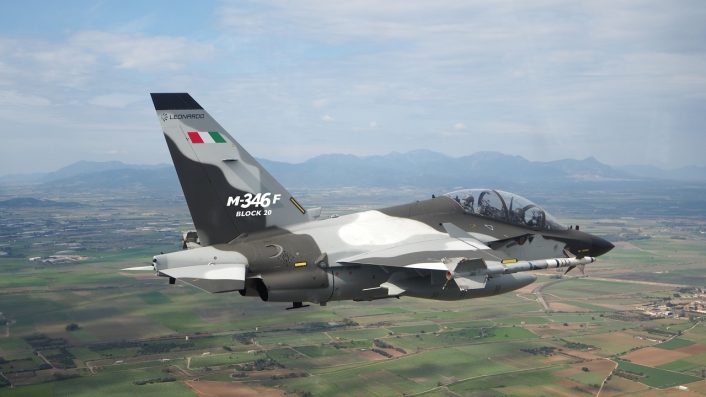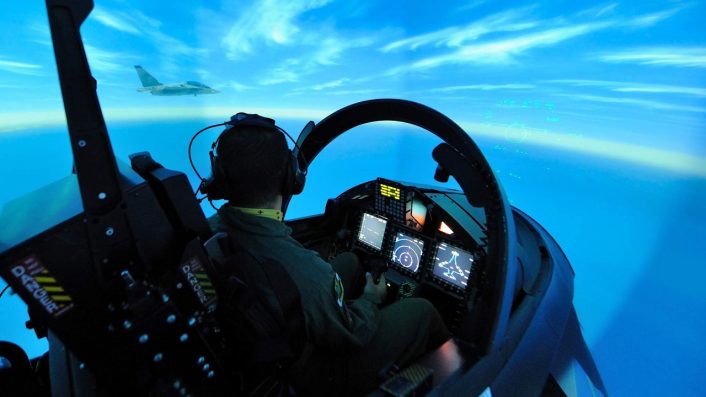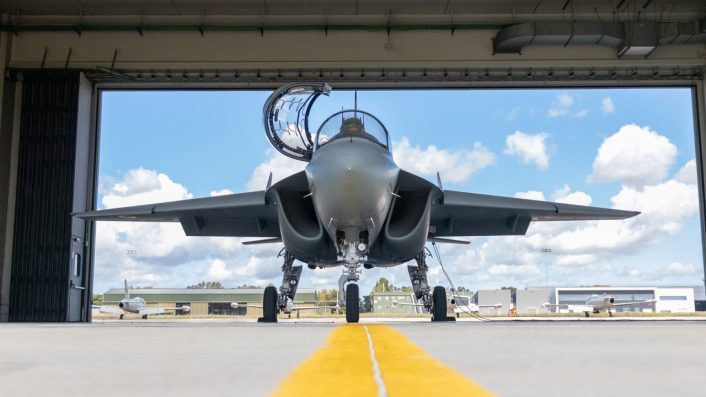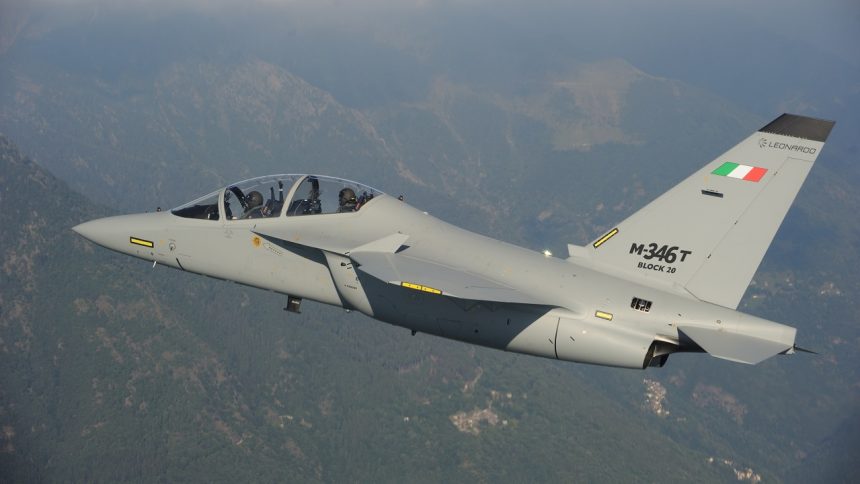The upgrade will involve the aircraft’s core avionics, navigation/identification, mission equipment and ground training capabilities, in order to meet modern training and operational requirements.
Leonardo has just announced at Farnborough International Air Show the launch of a comprehensive capability enhancement package for the M-346 integrated training system, including the aircraft’s core avionics, navigation/identification, mission equipment and ground training capabilities. This major upgrade comes as the M-346 fleet surpassed 100,000 flight hours as well as ten years of service.
The company says the move reflects the training needs to align pilot’s skills to the evolution dictated by modern multi-domain battlefields, combat air technology, and information management. This latest development leverages the inherent growth capability embedded into the M-346 design as well as the in-service experience with multiple operators.
Both M-346 AJT (Advanced Jet Trainer) training and M-346 LFFA (Light Fighter Family of Aircraft) fighter variants will benefit from these enhancements for a wide spectrum of applications, while implying significant margin for further developments in the future. Leonardo said that ‘M-346 T Block 20’ and ‘M-346 F Block 20’ are the designations for the new standard of both aircraft.
“Training represents a core area of expertise at Leonardo and the M-346 integrated training system is the backbone of our value proposition to ensure fighter pilots are well prepared to face modern and complex air challenges, today and in the future,” said Lorenzo Mariani, Co-General Manager of Leonardo. “As we are fully involved into next generation combat air developments, this latest progress of the M-346 testifies that we’re making sure the most appropriate training solutions are thoroughly embedded in this commitment. We strongly believe the type’s constantly evolving features will continue to deliver second-to-none benefits for users in its market segment, both for training and operational / light fighter roles, making it an ideal candidate for the future of fighter training in Europe and in other geographies.”

The Block 20 upgrade
In the press release, Leonardo said the new Block 20 standard will not be limited to the platform itself, but rather to the entire system including the ground-based training system. Interestingly, the company also added that the work shall be enabled by the widespread implementation of digitalization powered by AI.
The Block 20 standard cockpit will be completely renewed, featuring two Large Area Displays (LAD), one per each seat, replacing the existing six Multi-Functional Displays (MFD), plus a low-profile Head-Up Display (HUD). These will be combined with a new digital video and data recorder and a new augmented reality Helmet Mounted Display (HMD).
The new cockpit will align the human-machine interface to those of current and future frontline combat air systems, with advantages in terms of quality of training (i.e. look & feel plus a high-fidelity immersive environment) and situational awareness in operational missions. In fact, LADs and HMDs are becoming the standard in most modern combat aircraft, such as the F-35, the Typhoon P4E, the F-15EX and the F/A-18E/F Block III.
The M-346 Block 20 will also benefit from new navigation, weapon management, flight management system, IFF (Identification of Friend or Foe) transponder. Specifically for the M-346 F variant, further critical capability enhancements include an AESA (Active Electronically Scanned Array) radar featuring fire control radar capability, integration of new weapons for both air-to-air and air-to-ground roles in addition to a built-in missile datalink.
The whole Ground Based Training System (GBTS) holistic approach to training, with multi-media and classroom course, flight/mission simulation, virtual and live/constructive training, will step up to the new standard via virtual reality support and AI applications, said Leonardo. Moreover, stronger digitization will also result into a key enabler for more efficient technical support thanks to the implementation of the virtual maintenance and the “connected fleet”, an extremely high performing infrastructure, which uses Advanced Data Analytics and High Performance Computing to enhance the Integrated Logistic Support services.

The M-346 Integrated Training System
As we often reported, the introduction into service of the T-346 revolutionized the training. The M-346 is not just an aircraft, but an integrated system associated with simulators and multiple training aids. It’s the ideal system to train future fighter pilots which are not only required to be good pilots, but they also need to manage the entire weapon system with all its sensors and weapons in scenarios which are getting more complex, less permissive and with plenty of threats.
The GBTS, a fundamental part of the training system, is one of the most complete ever produced, and is composed by the Computer Based Training and a network of simulators which comprises Simulation Based Training, Partial Task Trainer, Full Mission Simulator. The other ground devices are the Real Time Monitoring Station and the Mission Planning and Debriefing Station.
The GBTS allows pilots to learn formation flight, basic maneuvers, advanced combat tactics, both day and night, without the need to get wheels off the ground. This allows a reduction of the flight hours required to compete the training of future fighter pilots of the latest generation aircraft, lowering the costs and improving the efficiency and availability of the fleet for operational tasks.
While the cost reduction is important, the M-346 ITS is unique because it allows the creation of the Live Virtual Constructive environment, an integrated training environment where the real and virtual worlds merge into a single operational scenario in which pilots in the simulators can interact with pilots flying on the real aircraft. This way, future Eurofighter and F-35 pilots can operate simultaneously real flights (live), simulators (virtual), and add at the same time different types of computer-generated threats (Constructive).
The T-346s also have an integrated onboard Embedded Tactical Training System (ETTS), which allows the simulation of sensors, weapons, simulated forces so that pilots can interact in real time with a tactical virtual scenery. Among these, we find advanced simulations of radar, datalinks, targeting pods and all kind of sensors used on modern fighters.
The M-346 has an advanced aerodynamics with high thrust-to-weight ratio and supersonic speed which, coupled with fly-by-wire controls and modern and efficient turbofan engines, makes it a trainer with high performances and high maneuver energy, that put the aircraft on a completely different level compared to other trainers. Thanks to its performance and capabilities, the T-346 is considered on the same level of the F-16 Fighting Falcon.
All these capabilities allow the pilots to develop all the skills they need before moving to the Operational Conversion Units. The aircraft’s performances have been further expanded recently, with the increase of the maximum allowed angle of attack from 25° to 30° and the increase of the G limit when the aircraft is equipped with a centerline external fuel tank from 5 G to 6 G.

The M-346 Light Fighter Family of Aircraft
The prototype of the M-346 Light Fighter Family of Aircraft (LFFA), , formerly known as M-346 Fighter Attack (FA), performed its first flight in 2020. The most visible differences from the standard AJT configuration are the two wingtip missile rails, that bring the total hardpoints to seven (two on the wingtips, four under the wings and one under the fuselage), a couple on new antennas on the nose (in front of the cockpit) and under the fuselage (under both engines), and the Defensive Aid Sub System (DASS).
The DASS features a Radar Warning Receiver (RWR), probably the new SEER digital RWR developed by Leonardo with sensors in the tail and near the wing root’s leading edge (beside the air intakes), a Missile Warning System (MWS), with two sensors along the RWR ones beside the air intakes and two near the wing root’s trailing edge, together with chaff/flare dispensers.
The M-346 LFFA variant is designed to retain the full dual role capability of the AJT version, already in service with the Italian, Israeli, Polish and Singapore Air Forces, while incorporating also some new features like a tactical data link, Grifo-346 mechanical scan, multi-mode radar, new secure radios and IFF system (Identification Friend or Foe), and a stronger airframe.
The aircraft, which is being proposed for Homeland Defence/Air Policing, Slow Mover Intercept, Close Air Support (CAS), Counter INsurgency (COIN), Forward Air Controller – Airborne (FAC-A), Combat Search And Rescue (CSAR), Interdiction, Battlefield Air Interdiction (BAI), Tactical Air Support for Maritime Operations (TASMO) and Tactical Reconnaissance roles, can carry more than 2,000 kg of weapons.
The M-346 LFFA maintains the air-to-air refueling capability of the M-346 AJT, being able to perform about two and half hours missions at about 500 nm from the homebase, depending on the mission type and the presence of external fuel tanks.









